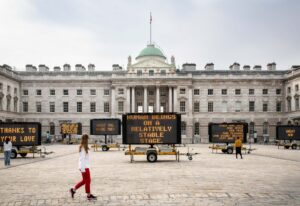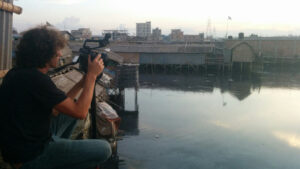
Justin Brice – Environmental Artist
Environmental artist Justin Brice encourages others to take a critical look at the relationship between humans and the planet.
MOOD OF LIVING February 25, 2015
In his breathtaking artwork, Jimmy Wright, painter and printmaker, focuses upon a sense of deep, meaningful symbolism, rather than delving into realistic depiction. As said by Wright himself, “I think of it as symbols of a deeper engagement with the shifts and unexpected changes, of the vagaries of nature and life.” Working in both pastels and oil paints, and finding inspiration in Roman wall paintings, Henri Matisse, flowers, and more, Wright’s artistic pieces are of fascinating diversity. They are emotionally evocative explorations into the wonders of life.
Artist Jimmy Wright was born in Union City, Tennessee in 1944. After receiving a Bachelor of Fine Arts from the School of the Art Institute of Chicago in 1967, he received a fellowship enabling him to study art around the world; he traveled to Europe, Asia, the Middle East and Africa. Upon returning to the United States, he went on to earn a Masters of Fine Arts from Southern Illinois University in 1971. His work is displayed in many public and private collections, including the Metropolitan Museum of Art and the Art Institute of Chicago.
Mood of Living: Current location?
Jimmy Wright: Freeman Alley, New York City.
MoL: Before your current occupation you were…?
JW: I have always been an artist.
MoL: Where do you see yourself in 10 years?
JW: I see myself painting in my NYC studio. I love New York and have no intention of growing old elsewhere.
MoL: What and/or who inspired you to become an artist?
JW: Since I was eight years old I knew that I would be an artist. I was inspired by the very best of photojournalism. The photographs in Life Magazine served as my window to the larger world. I was a small kid, living on a farm, in a very rural section of Western Kentucky. When I was about 12, I received as a gift my first art book, featuring paintings from the Louvre. I was taken by a Brueghel painting of beggars and an El Greco portrait of a man in a ruffled collar. I remember copying those paintings in watercolor.
MoL: Where and how did you learn your craft?
JW: My most important lessons on handling paint were from watching a talented fellow art student (who tragically died young) paint while we were students in a small state college in Western Kentucky. I went on to study painting with Ray Yoshida at the School of the Art Institute of Chicago. Yoshida’s emphasis was not so much on the craft of the materials as it was on the craft of the content of the work. Looking at Degas taught me the craft of using pastel.
MoL: What medium do you like to work in?
JW: I work primarily in two mediums: soft pastels on paper and oil paint on canvas. I have a great passion for both mediums: pastel because it is as close to working in pure pigment as I can get; oil because of the endless color discoveries made while mixing paint. Working with pastel is like drawing because the pastel becomes an extension of the hand and the arm and in turn the eye. It’s for me a direct medium. The liquid consistency of paint requires a different strategy. The majority of my time making a painting is used in rearranging and removing the previously applied paint. I find oil painting to be indirect because I have to find the painting, reveal the form in what is obscure.
MoL: How would you describe your artwork and creative process?
JW: My art is not about realistic depiction or decoration. I think of it as symbols of a deeper engagement with the shifts and unexpected changes, of the vagaries of nature and life.
MoL: Where do you look for inspiration?
JW: In art history there are two main sources of inspiration in my art. One is Roman wall painting. I can look at the art of antiquity and always find inspiration in how time has eroded the precision of the forms and the vividness of the original color. The other art inspiration would be Matisse, who is an endless source of formal invention. If one is thinking of inspiration through looking at objects, certainly flowers are an obvious source of inspiration. In the studio are collections of dried flowers. I have a kind of cabinet of curiosities for small treasures. Throughout the house and studio are groupings of objects that give me inspiration. I use picture shelves and low benches to display collections of butterflies and insects, photographs, paintings and framed works on paper.
MoL: You explore diverse floral imagery in many of your works. How did this artistic affinity towards flowers evolve? What is so thrilling, as an artist, about examining the realm of blossoms?
JW: It came about through circumstance – I was a full time caretaker to a loved one who was ill and I needed to find a way to get to the studio not on a schedule, but when I could find time. This was in 1988. I had never worked from still life before, but that was a choice I made because a still life wouldn’t move and I could compose a set-up and leave it and came back to it. It was serendipity that I bought a large sunflower head in the farmer’s market and that became the subject of two of eight large-scale paintings done over the course of three years. That was the beginning of the flower series.
MoL: What types of flowers evoke a creative spark within you and why? What qualities of flowers do you hope to capture in your work?
JW: All flowers are evocative. However, I am not a realist so I am not rendering fresh bouquets of flowers. What interests me most is painting the essence of a flower or that, which remains after the flower fades. Sunflowers have a form that I keep returning to.
MoL: What is your favorite quote?
JW: To say that a thing is beautiful is simply an act of faith. Not a measurement on some kind of scale.” – Édouard Vuillard
MoL: How do you achieve peace of mind and spirit?
JW: Despite the hard work, the act of painting gives me the most peace of mind and spirit.
MoL: What is your favorite hobby?
JW: Eating good food. Drinking very fine wine.
MoL: Who is an influential figure in your life?
JW: I look up to men and women of principle. Most of my male heroes are painters from past generations like Ryder and Hartley. My favorite contemporary painters are strong visionary women who paint against the grain: Olive Ahyens, Anne Harris, Louise Fishman, Barbara Takenaga, Susanna Coffey to name a few.
MoL: If you could have a conversation with any artist of the past or present, who would it be and why?
JW: I am fortunate in that I can have a conversation at any time with any past or present painter by looking at their work. And that’s the great joy of painting – even though you’re making a static fixed object, it is, when gazed upon, in fact alive. Painting conveys, through inanimate materials ideas, emotions and responses that are not set in time.
MoL: What period of art do you most admire?
JW: I admire the art of now. Contemporary art.
MoL: When was the moment you realized you could really do this?
JW: When I finish a work or a painting and realize that I’ve accomplished something, a strong painting, my immediate response is – how did I make that? So it’s never – for me – a moment that I’ve been able to sustain. The realization is only momentary. And that is part of what drives me to make the next painting.
MoL: What is the message you hope to project through your artwork? What feelings do you hope to convey?
JW: Painting is similar to the early space probes we’ve launched into space. A painting is simply a sign or a symbol, a message that life was here.
MoL: What advice can you give to anyone interested in becoming an artist?
JW: If you’re only thinking that you’re interested in art, then you’re not an artist. You either are an artist or not and for some it takes time to come to that realization. It’s not a lifestyle. It requires education, social and financial sacrifice, having an inner life, and having the capacity for joy.
MoL: We find that people who make beautiful things are more likely to lead an artistic lifestyle. Do you spend much time creating a beautiful home?
JW: It is more to me an organic process – a room is like a collage. I put something in and take something out, move something to one side or another. Play with the color of a wall, or the color of an object. I consider every room to be a comfortable refuge, but not fixed, flexible, a curated reflection of my domestic life. I have an art collection that is not static. Works are rotated and rearranged, moved in and out of storage. And sometimes the entire house becomes a stage for work projects.
MoL: Do you entertain?
JW: I love being with people, so I have to watch that I don’t spend all my time socializing rather than working in the studio. I have a group of friends who come for extended visits. I love entertaining, especially parties and events, because my living room welcomes large groups. That ties into my approach of how everything in a room should be flexible and moveable, though I do have a nine-foot marble dining table designed by James Wong that is not moveable.
MoL: Do you cook?
JW: My kitchen has two stoves. I cook for myself but now I much prefer eating other people’s food. One of my favorite chefs is Marja Samson. Mixing a color is like cooking from a secret recipe. I use Vasari oil paint which is made by hand in small batches with only the purest raw ingredients. It’s food for my eyes.
Photography courtesy of Jimmy Wright

Environmental artist Justin Brice encourages others to take a critical look at the relationship between humans and the planet.

Internationally recognized filmmaker Andrew Morgan focuses on telling stories for a better tomorrow for various film and new media projects.

Throughout his work with Ala Plástica and Casa Río Lab, environmental activist and artist Alejandro Meitin unites social engagement, art, and sustainability.